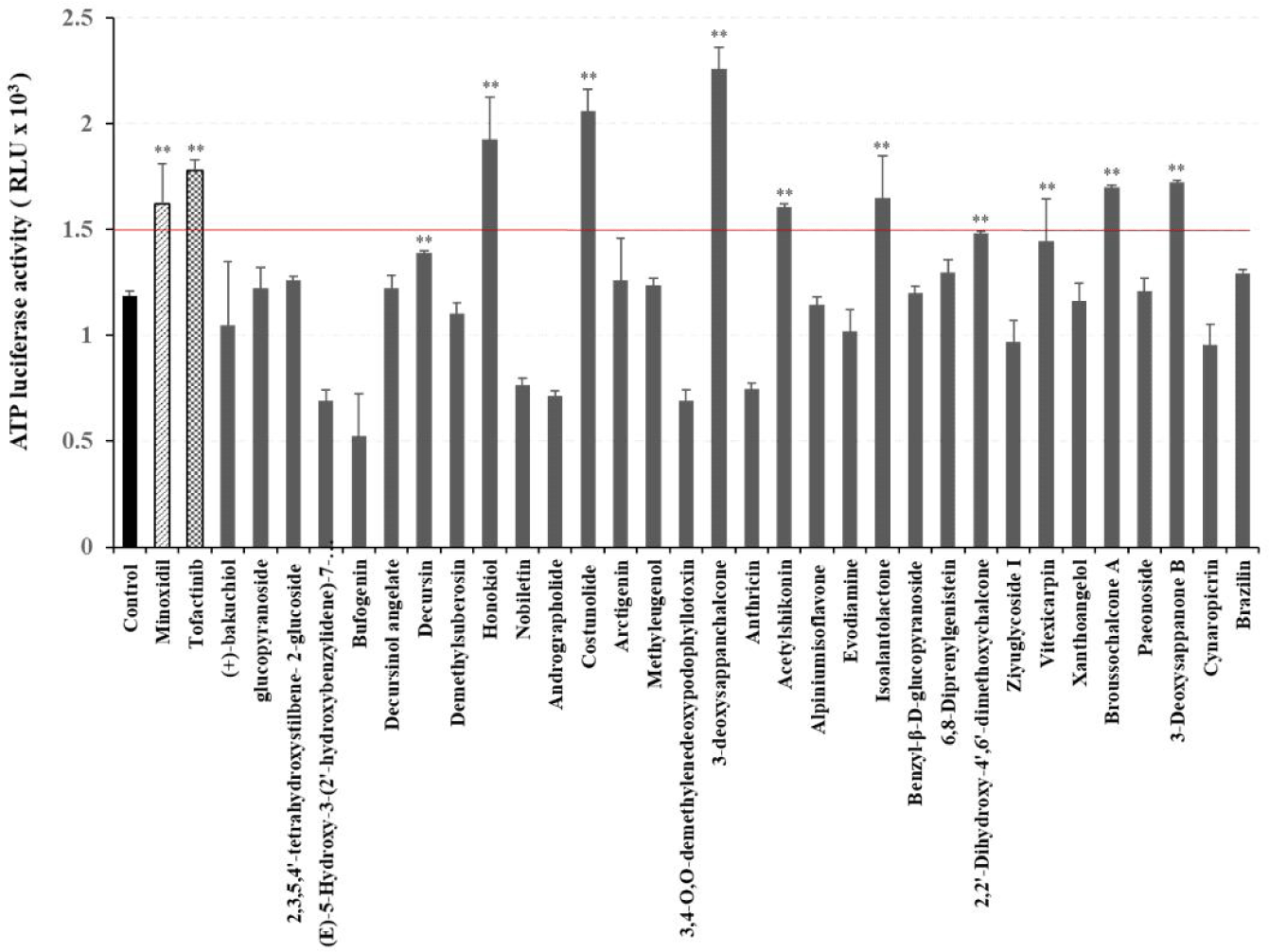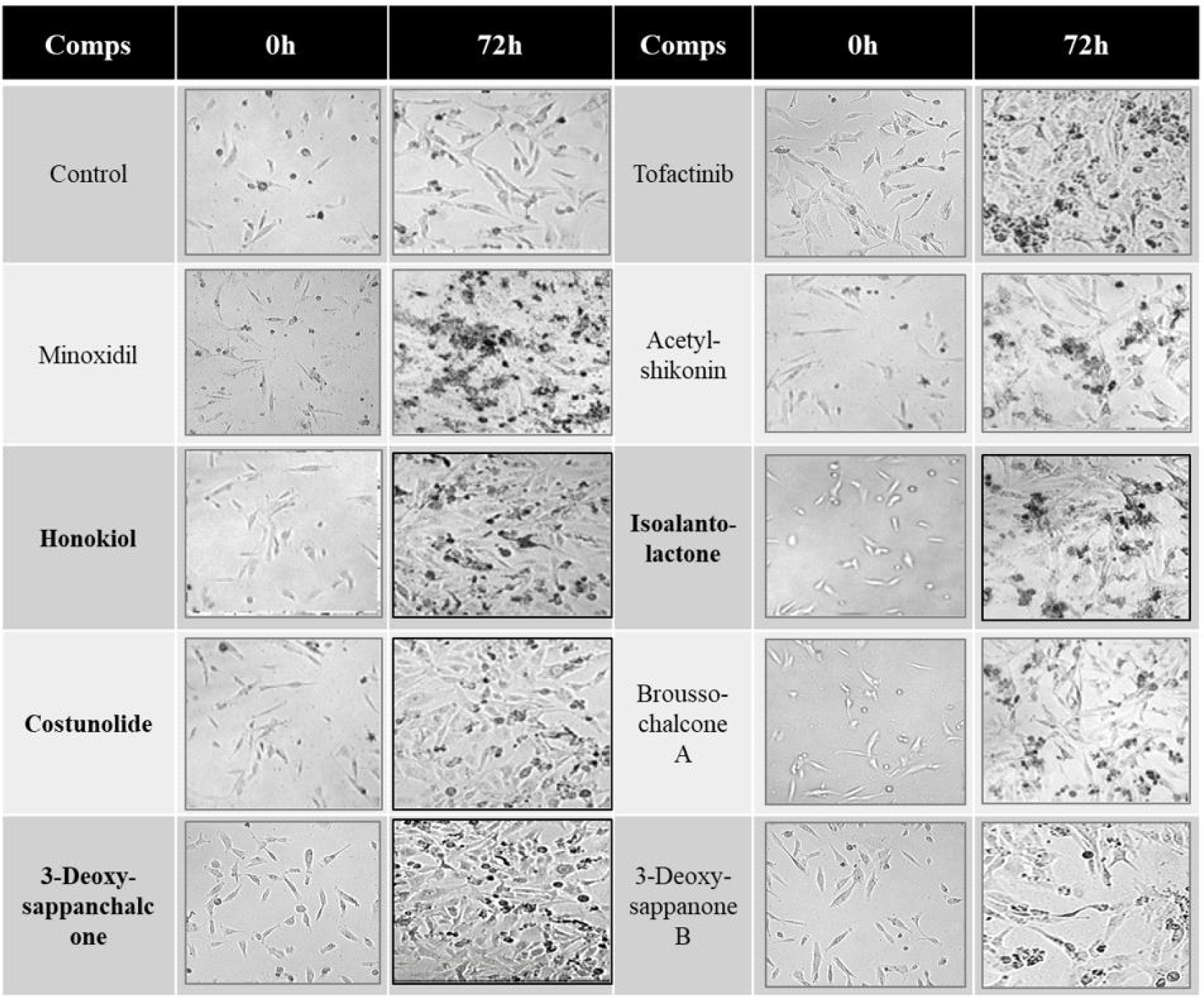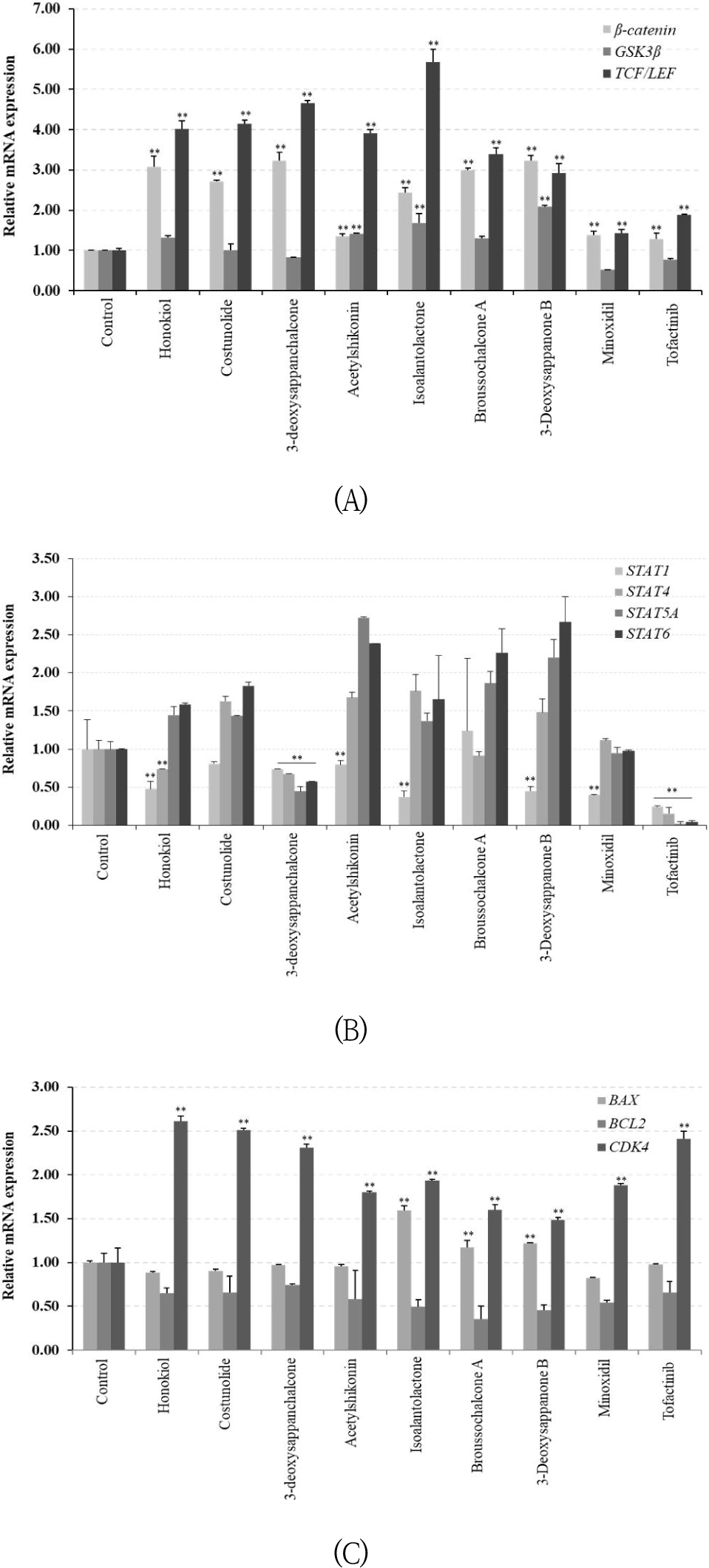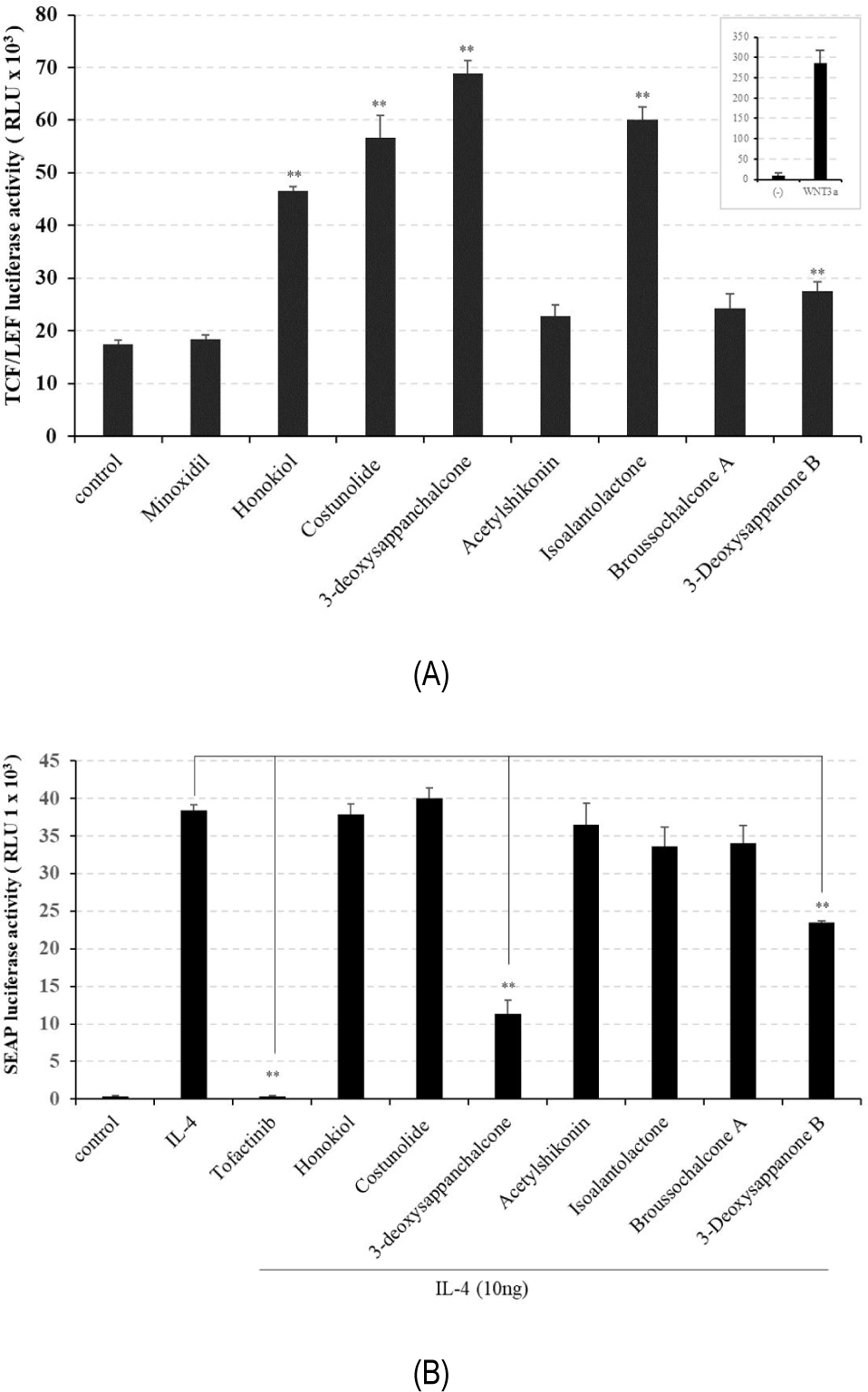Research Article
천연 생약에서 추출한 지표성분들의 모발 성장에 미치는 영향
최부영
1
,
*

Effects of Natural Herbal Marker Compounds on Human Dermal Papilla Cell Growth Regulation
Bu Young Choi
1
,
*

Author Information & Copyright ▼
1Department of Pharmaceutical Engineering & Science, Seowon University, Chungju, Chungbuk 28674, Korea
*Corresponding author : Bu Young Choi, Department of Pharmaceutical Engineering & Science, Seowon University, Chungju, Chungbuk 28674, Korea, Tel: +82-43-299-8411, Fax: +82-43-299-8490, E-mail:
bychoi2023@gmail.com
Copyright © Korean Society for Lactic Acid Bacteria and Probiotics. This is an Open-Access article distributed under the terms of the
Creative Commons Attribution Non-Commercial License (http://creativecommons.org/licenses/by-nc/4.0/) which permits
unrestricted non-commercial use, distribution, and reproduction in any
medium, provided the original work is properly cited.
Received: Aug 22, 2023; Revised: Sep 25, 2023; Accepted: Oct 05, 2023
Published Online: Dec 31, 2023
Abstract
Many people around the world are stressed by hair loss, and drug-based therapies (minoxidil, finasteride) are available for the treatment of alopecia, but they have several side effects. Therefore, in order to reduce the side effects of anti-hair loss drugs, the use of new treatments using products developed from natural extracts has been emphasized. In this study, we focused on the mechanisms underlying the hair growth-promoting effects of marker compounds of natural herbal extracts. The 32 marker compounds of natural herbal (10 μM) were used to evaluate the growth of human hair follicle dermal papilla cells, the expression of mRNA genes, and the signaling transcription factor activities of Wnt and JAKs. Seven marker compounds were selected that induced equal or greater growth than minoxidil or tofacitinib in cell growth. For the seven marker compounds, we evaluated the expression of mRNA genes and the transcriptional activities of Wnt/β-catenin and IL-4/JAK3-STAT6, which are major signaling pathways that regulate hair growth. As a result of the evaluation, it was scientifically proven that the 4 marker compounds (honokiol, isoalantolactone, broussochalcone A, and 3-deoxysappanone B) induce hair growth. I have suggested the possibility of developing a natural product for improving hair loss with 4 marker compounds.
Keywords: natural herbal marker compounds; hair growth; Wnt; JAKs; human hair follicle dermal papilla cells
서 론
인간의 두피 모발은 외부 환경의 온도 변화나 충격의 흡수, 자외선 등으로부터의 보호를 하며, 인상의 약 70%를 결정한다. 현대에 들어와서도 역시 건강한 모발은 매력적인 외모의 기본으로 작용하고 있으나, 현대인이 생활하고 있는 환경적 요인인 기후, 스트레스, 음식뿐 아니라 유전적 소양과 같은 다양한 이유로 인해 탈모 환자가 급격히 증가하고 있다. 이러한 이유로 탈모 예방 혹은 치료에 효과적인 의약품을 비롯하여, 준 의학적인 시술, 두피 케어라고 불리는 미용 시술과 관련 모발 관련 제품의 시장은 급격히 팽창하고 있으며, 또한 인터넷을 비롯한 여러 대중 매체를 통해 관련된 정보의 양 또한 급속하게 증가하고 있다(Sebetic et al., 2008; Trueb, 2015; Wu et al., 2022). 탈모란 모발의 밀도가 저하되거나 가늘어져 빠지는 현상을 말하며, 가역적인 비반흔성 탈모와 영구적인 반흔성 탈모가 있다. 비반흔성 탈모는 대표적으로 원형탈모, 안드로겐성 탈모 등이 있고, 반흔성 탈모는 자가 면역질환이나 외상 등으로 모근, 모낭이 영구적 손상을 입은 유형이다(Phillips et al., 2017). 현재 탈모는 남녀를 가리지 않고 발생하며 식습관, 스트레스, 생활환경 등 다양한 요인이 원인으로 지목되고 있다. 또한 현대인들의 삶에 많은 영향을 미치고 있으며 대표적으로 탈모는 자신감 저하, 우울, 대인기피 등이 있으며 삶의 질에 밀접한 관련이 있다(Kim, 2010; Lee, 2010). 그러나 아직 탈모에 대한 근본적인 치료법은 개발된 것이 없으며 예방 방법이 주로 연구되고 있다(Jang, 2015; Kim, 2019). 탈모는 성모가 두피로부터 이탈하는 현상으로 모낭과 관련이 깊다. 모낭은 일생 동안 성장기(anagen), 퇴행기(catagen), 휴지기(telogen)를 거치게 되는데 모낭의 성장기는 2~8년 정도 지속되고 활발한 성장기로 이 단계 동안 내부뿌리초와 모간을 통해 모간의 길이를 조절하고 성장기 후에 퇴행기가 진행된다. 퇴행기는 4~6주 정도 지속되며 이 기간 동안 모발의 구근 상피세포, 외부 근초 및 최 외측 상피 층에 세포자멸사(apoptosis)가 증가하여 세포 순환의 감소가 일어난다. 그리고 휴지기 단계는 2~3개월 동안 지속되며 전체 모발의 6~8%를 차지한다(Alonso and Fuchs, 2006). 모근 세포 내에 존재하는 5α-reductase의 수용체는 두피 모낭 주위에 많이 분포되어 있으며 5α-reductase의 활성도가 높고 DHT (dihydrotestosterone)에 유전적 소인이 있는 사람의 두피에서 남성형 탈모증이 발생한다(Morgan and Rose, 2003). 현재 대표적으로 사용 중인 탈모치료제는 finasteride와 dutasteride 그리고 minoxidil이 있으며 finasteride와 dutasteride는 전립선치료제로 개발되었고 또한 minoxidil은 고혈압치료제 개발 중 탈모 개선을 위한 적응 증에 적용되었다. 그러나 부작용으로 발기부전, 피로감, 두피건조, 가려움증 등이 나타나고 있는 단점이 있다(Arif et al., 2017; Hagemann et al., 2005; Lee, et al., 2019; McClellan and Markham, 1999). 따라서 이러한 부작용을 완화할 수 있는 안전성과 안정성이 확보되어 탈모 예방 및 모발 성장 강화 효과를 가진 의약품 및 천연소재의 개발이 필요하다(Rastegar et al., 2013). 부작용의 문제점들을 해결하기 위해 위험이 적은 천연물 또는 그 추출물을 이용한 탈모 예방에 대한 관심이 높아지고 있다. 현재 천연 성분을 사용하여 판매되는 제품에는 헤어 토닉, 모발 성장 촉진제, 헤어 컨디셔너 및 헤어 클렌저의 형태로 탈모를 예방하는 데 사용되는 제품이 포함되어 있다(Jain, 2016). 폴리페놀(polyphenols), 플라보노이드(flavonoids), 테르페노이드(terpenoids), 카로티노이드(carotenoids), 지방산(fatty acids)등 모낭(hair follicle) 건강 유지에 도움이 되는 성분을 함유하고 있다(Dzialo et al., 2016). 식물 기반 제제는 저렴한 재료로 쉽게 구할 수 있다는 장점이 있으며, 무독성 효과는 고대부터 알려져 있다. 천연 제품이 탈모 예방에 널리 사용되지만 정확한 작용 기전에 대한 연구 결과는 거의 없다. 최근 연구 진행이 활발하면서 탈모 과정에 관여하는 세포 내 신호 전달 경로, 특히 진피 유두 세포의 세포 주기 변화와 관련된 신호 전달 경로를 규명하는 데 상당한 진전이 있다. 모낭은 주기 동안 다양한 억제 및 자극 신호전달의 영향을 받는다. 신호전달 경로 중 모발 성장의 중요한 경로인 Wnt/β-catenin 신호전달 경로는 모낭의 개시, 발생에 필수적인 역할을 한다. Wnt/β-catenin은 frizzled에 결합하는 당 단백질로 이 신호가 활성화되면 GSK3β 복합체가 low-density lipoprotein receptor-related protein 5/6 (LRP5/6)를 인산화 한다. 인산화 된 LRP5/6는 axin을 통해 β-catenin을 인산화를 차단하고 β-catenin은 핵 안으로 전위되어 T cell factor/lymphoid enhancer factor (TCF/LEF)와 결합 후 모발의 형태 형성, 성장 및 유지를 촉진시킨다(Millar, 2002). 모낭의 표적 분자인 janus-activated kinase(JAK) 및 signal transducer and activator of transcription (STAT)는 다분화능 상피 줄기 세포(multipotent epithelial stem cells)의 성장기에 이러한 신호 분자의 활성화가 모낭의 세포 주기를 촉진한다(Gentile and Garcovich, 2019; Premanand and Reena Rajkumari, 2018; Ramot and Zlotogorski, 2020). 본 연구는 천연 생약에서 추출한 지표 성분 32종에 대한 인간 모낭진피유두세포 (human hair follicle dermal papilla cells)의 성장 효과와 분자적 신호전달 시스템인 Wnt/β-catenin과 IL-4/JAK3-STAT6을 평가하여 주요 성분에 대한 모발 촉진과 탈모 예방을 위한 연구 및 제품 개발 가능성을 보여주고자 한다.
재료 및 방법
천연 생약 추출물의 지표 성분 및 세포 배양
본 연구에서는 한국물질은행에서 천연 생약 추출물을 분리, 정제한 지표 성분을 분양 받아 사용하였다(Table 1). 인간 모낭진피유두세포(hHDPC: human hair follicle dermal papilla cells., Abm Inc; Richmond, BC, Canada)는 페니실린-스트렙토마이신(Penicillin-Streptomycin., Gibco™, Thermo fisher scientific, Waltham, MA, USA)100 U/mL 의 농도로 사용하였고 10% 태아 소혈청(fetal bovine serum; FBS., HyClone™, Marlborough, MA, USA)이 함유된 Dulbecco's modified Eagle's medium (DMEM., Corning, NY, USA), 배지로 37℃, 5% CO2 배양기에서 유지하였다. Wnt 리포터 NIH3T3 세포 주는 Wnt 표적 유전자 발현을 활성화하기 위한 TCF/LEF luciferase 전사 인자에 대해 Enzo life science(Farmingdale, NY, USA)로부터 입수하였다. HEK293 세포 주에서 발현하는 안정한 HEK-Blue-STAT6 전사 인자의 SEAP Luciferase 리포터 유전자는 Novus (Littleton, CO, USA)에서 구입하였다. TCF/LEF와 SEAP 리포터 세포는 제품 설명서에 따라 배양하고 37℃, 5% CO2 배양기에서 유지했다.
Table 1.
List of 32 marker compounds isolated and purified from natural herbal extracts
| Herbal |
Marker compouds |
Molecular weight |
Purity (%) |
| Psoralea corylifolia Linn |
(+)-Bakuchiol |
256.38 |
76 |
|
Rubiae radix
|
1,3,6-Trihydroxy-2-methyl-9,10-anthraquinone-3-O-(6'-O-acetyl)-α-L-rhamnopyranosyl-(1→2)-β-D-glucopyranoside |
620 |
99.01 |
|
Polygonum multiflorum
|
2,3,5,4'-Tetrahydroxystilbene-2-glucoside |
406.3 |
97.5 |
|
Portulaca oleracea
|
(E)-5-Hydroxy-3-(2'-hydroxybenzylidene)-7-methoxy-4-chromanone |
331 |
84.6 |
|
Bufo bufo bargarizans
|
Bufogenin |
384.508 |
99.9 |
|
Angelica gigas
|
Decursinol angelate |
328.36 |
76.864 |
| Decursin |
328.36 |
98.6 |
| Demethylsuberosin |
230.26 |
90.831 |
|
Machilus thunbergii
|
Honokiol |
266.34 |
96.017 |
|
Nelumbo nucifera
|
Nobiletin |
402.395 |
97.303 |
| A. paniculata Nees |
Andrographolide |
350.45 |
98 |
|
Inula helenium
|
Costunolide |
232.318 |
98 |
|
Arctium minus
|
Arctigenin |
372.41 |
99.694 |
|
Vitis rotundifolia
|
Methyleugenol |
178.23 |
89.391 |
|
Hernandia ovigera
|
3,4-O,O-Demethylenedeoxypodophyllotoxin |
386.4 |
95.568 |
|
Artiodactyla
|
3-Deoxysappanchalcone |
270 |
92.407 |
|
Anthriscus
|
Anthricin |
398 |
99.01 |
|
Lithospermum officinale
|
Acetylshikonin |
330.33 |
50.942 |
|
Rinorea welwitschii.
|
Alpiniumisoflavone |
336.1 |
98.228 |
| Evodia rutaecarpa Bentham |
Evodiamine |
303.36 |
98.735 |
|
Inula helenium
|
Isoalantolactone |
232.3181 |
61.776 |
|
Prunus mume
|
Benzyl-β-D-glucopyranoside |
270 |
93.971 |
|
Erythrina senegalensis
|
6,8-Diprenylgenistein |
406.18 |
100 |
|
Portulaca oleracea
|
2,2'-Dihydroxy-4',6'-dimethoxychalcone |
301 |
86.944 |
|
Sanguisorba officinalis
|
Ziyuglycoside I |
766.97 |
99.152 |
| Vitex rotundifolia Linne Fil |
Vitexicarpin |
374.34 |
99.756 |
|
Angelica keiskei
|
Xanthoangelol |
392 |
98.514 |
|
Broussonetia papyrifera
|
Broussochalcone A |
340 |
99.146 |
|
Paeonia suffruticosa andrews
|
Paeonoside |
328 |
95.622 |
|
Artiodactyla
|
3-Deoxysappanone B |
286.3 |
98.694 |
|
Inula helenium
|
Cynaropicrin |
346.38 |
85.852 |
|
Artiodactyla
|
Brazilin |
286.28 |
95.119 |
Download Excel Table
Cell growth assay
인간 모낭진피유두세포 증식은 CellTiter-Glo® luminescent cell viability assay kit (Promega, Madison, WI, USA)는 대사 활성 세포의 존재를 나타내는 ATP의 정량을 기반으로 배양액에서 생존 세포의 수를 결정하는 방법이다. 간략히 설명하면, 세포를 96 well plate에 1×104 cell/well 넣은 후 24시간 배양 후 천연물 지표 성분들 10 μM 농도로 처리하여 72시간 동안 배양하였다. 결과를 확인하기 위해 각 well에 존재하는 세포 배양 배지의 부피와 동일한 부피의 CellTiter-Glo® reagent를 첨가하고 실온에서 10분 동안 반응한 후 발광되는 ATP의 양을 LuBi microplate luminometer (Berthold TEC GmbH & Co., Oakridge, TN, USA)에서 측정하였다. 실시간 살아 움직이는 세포의 성장(Real time live cell imaging)을 관찰하기 위해 JuLITM FL (NanoEntek, Guro-gu, Seoul, Korea)을 사용하여 세포 성장을 관찰 기록하였다. 모든 실험은 3번 이상 반복하였고, 평균값은 표준편차와 함께 표시하였다.
RNA 분리 및 real-time PCR
인간 모낭진피유두세포(5×105 cells/well)를 6-well plates에 접종하였고, 천연물 지표 성분 10 μM 처리하여 72시간 동안 배양시켰다. 그 후, aurum total RNA mini kit (Bio-Rad, Hercules, CA, USA)을 이용하여 총 RNA를 분리하였다. 1 μg의 총 RNA를 이용하여 moloney murine leukemia virus reverse transcriptase (MMLV-RTase) (Bio-Rad, Hercules, CA, USA)로 첫번째 가닥 cDNA를 합성하였다. 합성된 cDNA는 GeneAmp PCR 9700 thermocycler (Thermo fisher scientific, Waltham, MA, USA)를 사용하여 분자 표적 primer와 반응시켰다. 정량적 유전자 발현 수준은 CFX96 Touch PCR system (Bio-Rad, Hercules, CA, USA)상에서 SYBR Green reagents(Bio-Rad, Hercules, CA, USA)로 측정하였다. 상대적 표적 유전자 발현은 GAPDH 수준으로 표준화한 후에 측정하였다. 각각의 실험에 있어서, 2번의 독립적인 실험을 3번 반복하여 결과를 계산하였다. RT-PCR을 위한 primer 디자인은 Table 2와 같다.
Table 2.
mRNA primer pairs for real time-PCR
|
|
Forward |
Reverse |
|
β-Catenin
|
5’-CCCACTAATGTCCAGCGTTT-3’ |
5’-AACCAAGCATTTTCACCAGG-3’ |
|
Glycogen synthase kinase (GSK)-3β
|
5’-AACTGCCCGACTAACAACAC-3’ |
5’-ATTGGTCTGTCCACGGTCTC-3’ |
|
Lymphoid enhancer factor (Lef)-1/T Cell factor (TCF)
|
5’-AATCATCCCGGCCAGCA-3’ |
5’-TGTCGTGGTAGGGCTCCTC-3’ |
|
BAX
|
5’-GTTGTCGCCCTTTTCTACT-3’ |
5’-GAAGTCCAATGTCCAGCC-3’ |
|
BCL2
|
5’-CACCAGAATCAAGTGTTCC-3’ |
5’-GCTATTTTATTGGATGTGCTTTG-3’ |
|
STAT1
|
5’-ACATCATTCGCAATTACAAAGTC-3’ |
5’-TCAAGTTCCATTGGCTCTG-3’ |
|
STAT4
|
5’-AACCTACTCTTGATACACAATCTAA-3’ |
5’-TCTCCTCTCTTCCCTTAAACA-3’ |
|
STAT5A
|
5’-CTTTGCCCTCCTAAGAGAGA-3’ |
5’-TGAATCGGTTACATCAACACAT-3’ |
|
STAT6
|
5’-CCAGGATGGCTCTCCACAG-3’ |
5’-CATGGAGGAATCAGGGGC-3’ |
|
CDK4
|
5’-ACCTGAGATGGAGGAGTC-3’ |
5’-AAGGCAGAGATTCGCTTG-3’ |
|
GAPDH
|
5’-TGGCAAATTCCATGCAC-3’ |
5’-CCATGGTGGTGAAGACGC-3’ |
Download Excel Table
Reporter gene assay
Wnt/β-catenin 신호전달을 보기 위해 TCF/LEF luciferase 구조체로 형질 감염된 NIH3T3세포와 JAK3-STAT6 신호전달의 secreted alkaline phosphatase (SEAP)–luciferase로 형질 감염된 HEK293세포를 이용하였으며 세포는 96-well plate (3×103 cells/well)에 접종하였고, 10% FBS가 함유된 DMEM 배지에서 24시간 동안 유지하였다. 그 후, TCF/LEF luciferase는 양성대조군으로 Wnt 3a (50%, v/v) 또는 생약지표성분을 처리하였고 SEAP-luciferase로 형질 감염된 HEK293세포는 IL-4 (10 ng/mL)와 생약지표성분을 혼합하여 37℃, 5% CO2 배양기에서 48시간 배양하였다. 측정은 phospha-light system을 이용하여 세포 용해 후 luciferase 활성을 LuBi luminometer (Berthold TEC GmbH & Co., Oakridge, TN, USA)를 통해 측정하였다. 모든 실험은 적어도 3번 이상 반복하였고, 평균값은 표준편차와 함께 표시하였다.
통계처리
실험결과는 SPSS subscription (IBM SPSS Statistics, USA)를 이용하여 통계적 유의성을 평가하였다. 정규성은 shapiro-wilk test를 통해 검정하였으며, 정규성을 만족하면 모수 검정, 정규성을 만족하지 않으면 비모수 검정을 실시하였다. 통계분석 결과는 95% 신뢰구간에서 유의성 여부를 확인하였다. 전후 비교는 모수검증으로 paired t-test를 실시하였고, 비모수 검정으로 wilcoxon signed-rank test를 이용하였다.
결과 및 고찰
천연 생약 지표성분들의 인간 모낭진피유두세포 성장에 미치는 영향
본 연구에서는 천연 생약 지표성분들이 인간 모낭진피유두세포의 성장에 미치는 영향을 조사하였다. 양성대조군으로 minoxidil (0.4 μM)과 tofacitinib(0.4 μM)을 사용하였다. xCELLigence 시스템을 사용하여 실시간 세포 증식의 분석과 대사 활성 세포의 존재를 나타내는 ATP (CellTiter-Glo® luminescent lell viability assay kit)의 정량을 기반으로 배양액에서 생존 세포의 수를 결정한 결과를 기반으로 인간 모낭진피유두세포의 성장이 음성 대조군 대비 유의적 효과를 보이는 10종의 지표 성분(decursin, honokiol, costunolide, 3-deoxysappanchalcone, acetylshikonin, isoalantolactone, 2,2'-dihydroxy-4',6'-dimethoxychalcone, vitexicarpin, broussochalcone A, 3-deoxysappanone B)과 양성대조군 minoxidil 대비 동등 그리고 이상은 7종(honokiol, costunolide, 3-deoxysappanchalcone, acetylshikonin, isoalantolactone, broussochalcone A, 3-deoxysappanone B)이 있음을 확인하였다(Fig. 1). 모낭 진피유두세포 성장을 유도하는 생약 지표 성분 중 양성 대조군 대비 동등 또는 그 이상의 세포 성장을 보이는 7종을 선택하여 세포를 접종한 후 7종의 지표 성분을 처리하여 실시간 살아 움직이는 세포를 관찰하여 72시간에 세포 성장 형태를 관찰 기록하였다. 그 결과 양성 대조군인 minoxidil과 tofacitinib은 성장이 촉진됨을 관찰할 수 있었으며 honokiol, costunolide, 3-deoxysappanchalcone, isoalantolactone 성분도 양성 대조군 동등 수준으로 성장함을 관찰하였다(Fig. 2).
Fig. 1.
Effects of natural herbal marker compounds on hHDFP cell growth. To evaluate the effect of 32 natural herbal marker compounds on hHDFP cell growth using CellTiter-Glo® luminescent cell growth assay as described in the methods. 1 x 103 cell/50μL was inoculated into 96-well plate, treated with natural herbal marker compounds (10 μM) and cultured for 72 h. minoxidil (0.4 μM) and tofacitinib (0.4 μM) was used as a positive control. Each assay is representative for 3 experiments. The asterisk indicates a significant statistical significance (**p<0.05).
Download Original Figure
Fig. 2.
Cell proliferation and live cell images at 0 and 72 h after treatment of hHDFP cells with natural herbal marker compounds.
Download Original Figure
인간 모낭진피유두세포 성장을 유도하는 천연 생약 추출물 지표 성분의 mRNA 유전자 발현에 미치는 영향
세포의 성장을 유도하는 천연 생약 추출물 지표 성분 7종에 대한 모발 성장 조절 인자에 미치는 영향을 알아보기 위해 기존의 정량적 역전사 효소 PCR (RT-PCR)을 사용하여 다양한 유전자의 전사 발현 변화를 분석했다. 그 결과 7종 지표성분에서 Wnt/β-catenin 신호전달 체계의 주요 조절 유전자인 β-catenin, TCF/LEF의 발현이 음성과 양성 대조군 대비 증가함을 알 수가 있고 특히 isoalantolacton의 발현이 높음을 알 수가 있다(Fig. 3A). 양성대조군인 minoxidil (Huang and Senna, 2022)과 tofactinib (Ramot and Zlotogorski, 2020)는 이미 많은 연구결과에서 알 수 있듯이 Wnt/β-catenin 신호전달체계에는 영향이 없음을 알 수가 있다. 현재 Wnt/β-catenin을 조절하는 소재 개발을 위해 많이 연구 중에 있다(Jung et al., 2022; Liu et al., 2022). 다음으로 JAK family의 STATs 활성을 평가하였다. 염증성 사이토카인(cytokines)들에 의해 유도되는 JAKs-STATs 경로는 다양한 전 염증 신호를 전달하는 경로로 조혈 및 면역기능을 담당한다. JAK kinase들의 substrate로는 7가지의 STATs(STAT1, STAT2, STAT3, STAT4, STAT5a, STAT5b, STAT6)와 구조를 이루고 있다(Damsky and King, 2017; Paus et al., 2018). 모낭 세포의 세포성장, 증식, 생존 억제와 관련되어 있는 STAT 1, 4, 5 그리고 6의 유전자 발현을 평가하였다. 양성대조군으로는 류마티스 관절염 치료제로 개발되었으나 모발을 빠르게 성장시키도록 촉진하는 JAK 1, 3 억제제인 tofacitinib (Harel et al., 2015; Liu et al., 2017)로 비교하였다. 그 결과 7종의 생약 지표 성분은 tofacitinib 보다 억제율이 동등 또는 그 이상의 억제율을 관찰할 수 없었으나 3-deoxysappanchalcone에서 STATs의 mRNA유전자 발현이 억제됨을 알 수가 있었다(Fig. 3B). 인간 모낭진피유두세포의 성장 주기와 사멸을 조절하는 cycline dependent kinase 4 (CDK4)와 Bcl-2, Bax에서는 성장 주기의 G1 단계에서 honokiol, costunolide, 3-deoxysappanchalcone, acetylshikonin, isoalantolactone는 minoxidil대비 동등 또는 이상의 CDK4 유전자 발현이 증가함을 알 수가 있었다. Tofacitinib은 인간 모낭진피유두세포에서 유사한 패턴의 유전자 발현 변화를 관찰할 수 있었다 (Fig. 3C).
Fig. 3.
Gene expression. mRNA expression effects on hHDFP cells by natural herbal compounds. The gene expression of hair growth regulating factors was detected by real-time qPCR using primers in HDPCs. (A) β-catenin, TCF/LEF and GSK-3β primers, (B) STAT1, STAT4,STAT5A and STAT6. (C) BAX, BCL-2 and CDK4. Each assay is representative for 3 experiments. The asterisk indicates a significant statistical significance (**p<0.05).
Download Original Figure
인간 모낭진피유두세포에서 TCF/LEF와 STAT6의 전사 활성에 대한 생약지표성분의 효과
탈모증의 페러다임 변화를 가져올 수 있는 새로운 탈모 조절 표적 단백질은 Wnt/β-catenin 그리고 JAKs-STAT 경로를 조절하는 의약품 또는 기능성 소재에 초점을 맞추고 있다(Choi, 2020; Harel et al., 2015; Liu et al., 2017; Ryu et al., 2021). Wnt/β-catenin은 현재 개발된 의약품이나 기능성 소재는 없고 연구 개발 진행 중이며 이외의 류마티스 관절염 치료제인 tofacitinib의 경우는 야누스 인산화 효소(janus kinase)를 억제함으로써 다양한 염증 세포를 동시에 차단하는 약물로 탈모증 치료제 개발이 활발이 진행 중이다(Sanchez-Diaz et al., 2022). 본 연구에서는 NIH3T3-Wnt-luciferase 세포를 사용하여 TCF/LEF reporter 유전자 전사 활성에 대한 생약 지표성분들의 효과를 평가했다(Fig. 4A). 그 결과, honokiol, costunolide, 3-deoxysappanchalcone, isoalantolactone는 β-catenin 인산화 억제를 통해 β-catenin을 안정화시켜 TCF/LEF 활성화를 일으키는 것을 관찰했다. IL-4에 의한 JAK3-STAT6 신호전달 체계에서 SEAP reporter 유전자 전사 활성에 대한 생약 지표성분들의 효과를 확인하기 위해 SEAP luciferase reporter plasmid를 안정적으로 발현하는 HEK293 세포에 생약 지표성분들을 처리하여 STAT6 매개 luciferase 활성을 측정했다. 그 결과, 3-deoxysappanchalcone, 3-deoxysappanone B는 IL-4에 의한 JAK1/3 활성화로 STAT6 인산화가 억제됨을 알 수가 있었다(Fig. 4B). 효과를 보이는 생약지표성분이 진피 모낭 유두 세포의 분자 표적인 Wnt와 JAK1/3 신호전달 체계를 통해 모발의 성장을 조절함을 알 수가 있었다. 본 연구 결과를 기반으로 32종의 천연 생약 추출물의 지표 성분이 진피모낭유두세포 성장에 미치는 영향을 형태학적인 성장과 대표적인 표적 분자 유전자 조절에 대해 조사하였으며 그 중 costunolide (Kim et al., 2019), 3-deoxysappanchalcone (Kim et al., 2016) 두 성분에 대해선 앞선 분자 기전 연구를 실시하여 증명하였으며 두 성분의 결과와 비교하여 신규 가능성 있는 지표성분들의 실험 평가의 신뢰도를 높일 수 있었다. 천연물 생약 추출물로부터 탈모 조절 효능을 가지는 honokiol, isoalantolactone, broussochalcone A, 3-deoxysappanone B 성분에 대한 새로운 탈모 조절 단백질의 작용 메커니즘을 입증함으로써 현실적인 탈모 개선 제품의 개발 가능성을 제시하고자 한다.
Fig. 4.
Effects of natural herbal marker compounds on reporter gene assay. To evaluate the effect of 7 natural herbal marker compounds on TCF/LEF, which plays an important role in hair growth, Wnt-3T3 cells transfected with the TCF/LEF luciferase construct were inoculated at 3x103 cell/ 50μL or HEK293 cells permanently transfected with IL-4R site-TKluc/STAT 6 contained IL-4 receptor site were inoculated at 1×104 cell/ 50μL in each well of a 96-well plate in DMEM containing 5% FBS for 24 h. The activity of luciferase was measured after 48 h treatment with natural herbal marker compounds (10 μM). (A) TCF/LEF reporter gene activity, Wnt3a 50% was used as a positive control. (B) IL-4 induced STAT 6 reporter gene activity. Each assay is representative for 3 experiments. The asterisk(s) indicate a significant statistical significance (**p < 0.05).
Download Original Figure
요 약
전 세계적으로 많은 사람들이 탈모로 스트레스 받고 있으며 탈모증 치료를 위해 약물 기반 요법(minoxidil, finasteride)이 있으나 여러 부작용이 나타나는 상황이다. 따라서 탈모 방지 약물의 부작용을 줄이기 위해 천연물 소재로부터 개발된 제품을 사용하는 새로운 치료법의 사용이 강조되고 있다. 본 연구에서는 천연 생약 추출물의 지표성분들에 대한 모발 성장 촉진 효과의 기본 메커니즘에 주로 초점을 맞춘 연구이다. 총 32종의 천연 생약 지표 성분(10 μM)을 이용하여 인간 모낭진피유두세포의 성장과 주요 유전자 발현 그리고 Wnt와 JAKs의 신호전달 전사 인자 활성을 평가하였다. 세포의 성장에서 minoxidil과 tofacitinib 대비 동등 또는 그 이상의 성장을 유도하는 7종을 선택하였다. 7종의 지표 성분에 대해선 주요 mRNA 유전자 발현과 모발 성장을 조절하는 주요 신호 전달인 Wnt/β-catenin과 IL-4/JAK3-STAT6의 전사 활성에 대한 평가 결과 4가지 지표 성분(honokiol, isoalantolactone, broussochalcone A, 3-deoxysappanone B)이 모발 성장을 유도함을 과학적으로 입증했으며 4가지 지표 성분의 탈모 개선을 위한 천연물 개발 가능성을 제시하였다.
감사의 글
정제된 천연물 화합물을 제공해주신 강태훈 박사님(KOTMIN, 경산, 한국)께 감사드립니다.
References
Alonso L and Fuchs E (2006) The hair cycle.
J. Cell Sci.119, 391-393.



Arif T, Dorjay K, Adil M and Sami M (2017) Dutasteride in androgenetic alopecia: An update.
Curr. Clin. Pharmacol.12, 31-35.



Hagemann T, Schlutter-Bohmer B, Allam JP, Bieber T and Novak N (2005) Positive lymphocyte transformation test in a patient with allergic contact dermatitis of the scalp after short-term use of topical minoxidil solution.
Contact. Dermatitis.53, 53-55.



Huang KP and Senna MM (2022) Hair are the rankings-5-alpha reductase inhibitors and minoxidil in male androgenetic alopecia.
JAMA. Dermatol.158, 242-243.



Jain PK and Singhai A (2016) Alternative herbal drugs used for treating hair disease.
Asian. J. Pharm. Clin. Res.9, 75-77.

Jang IW and Yoon HJ (2015) The latest trends of treatment for alopecia.
The Journal of Korean Medicine Ophthalmology & Otorhinolaryngology & Dermatology, 28, 12-28.


Kim DH and Kim SN. (2010) The effect on hair loss for impression formation and interpersonal anxiety.
Asian. J. Beauty. Cosmetol.8, 247-258.

Kim JW, Jo A and Lee JH (2019) Analysis of the patent trends for natural components related to hair loss.
AJMAHS.9, 375-387.

Lee S, Lee YB, Choe SJ and Lee WS (2019) Adverse sexual effects of treatment with finasteride or dutasteride for male androgenetic alopecia: A systematic review and meta-analysis.
Acta. Derm. Venereol. 99, 12-17.



Lee SH and Lee JR (2010) Association of diffuse hair loss of adult male on stress, self-confidence, and depression.
Jounal of The Korean Society of Cosmetology.16, 1171-1179.

Liu LY, Craiglow BG, Dai F and King BA (2017) Tofacitinib for the treatment of severe alopecia areata and variants: A study of 90 patients.
J. Am. Acad. Dermatol.76, 22-28.



McClellan KJ and Markham A (1999) Finasteride: A review of its use in male pattern hair loss.
Drugs.57, 111-126.



Millar SE (2002) Molecular mechanisms regulating hair follicle development.
J. Invest. Dermatol.118, 216-225.



Morgan MB and Rose P (2003) An investigation of apoptosis in androgenetic alopecia.
Ann. Clin. Lab. Sci.33, 107-112.

Paus R, Bulfone-Paus S and Bertolini M (2018) Hair follicle immune privilege revisited: The key to alopecia areata management.
J. Investig. Dermatol. Symp. Proc.19, S12-S17.



Phillips TG, Slomiany WP and Allison R (2017) Hair loss: Common causes and treatment.
Am. Fam. Physician.96, 371-378.

Premanand A and Reena Rajkumari B (2018) Androgen modulation of Wnt/beta-catenin signaling in androgenetic alopecia.
Arch. Dermatol. Res.310, 391-399.



Ramot Y and Zlotogorski A (2020) Jak inhibitors for the treatment of alopecia areata.
Harefuah.159, 38-42.

Rastegar H, Ahmadi Ashtiani H, Aghaei M, Ehsani A and Barikbin B (2013) Combination of herbal extracts and platelet-rich plasma induced dermal papilla cell proliferation: Involvement of ERK and Akt pathways.
J. Cosme.t Dermatol. 12, 116-122.



Sebetic K, Sjerobabski Masnec I, Cavka V, Biljan D and Krolo I (2008) UV damage of the hair.
Coll. Antropol.32, 163-165.

Trueb RM (2015) Effect of ultraviolet radiation, smoking and nutrition on hair.
Curr. Probl. Dermatol,47. 107-120.



Wu W, Yang J, Tao H and Lei M (2022) Environmental regulation of skin pigmentation and hair regeneration.
Stem. Cells. Dev.31, 91-96.














